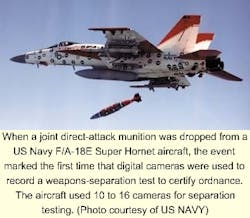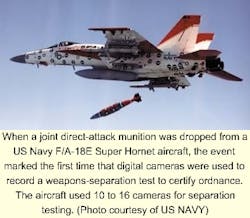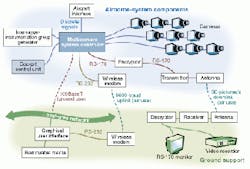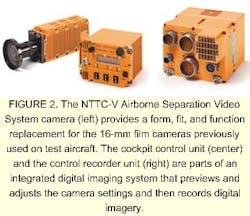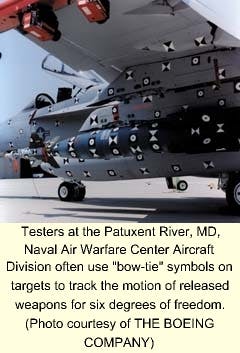Digital imaging certifies weapon separation
High-resolution digital imaging system qualifies the release of weapons from military aircraft more reliably than film cameras.
By John A. Baylouny
Released from military aircraft at high speeds or in aggressive maneuvers, bombs, missiles, fuel tanks, and other military stores (ordnance devices) require separation testing (release of device from aircraft) to certify their safety. Last March, a joint direct-attack munition was dropped from a US Navy F/A-18E Super Hornet aircraft. The event marked the first time the GBU-31 guided bomb was released from the new fighter jet and the first time digital cameras were used instead of film cameras to record a separation test to certify the ordnance.
The Airborne Separation Video System (ASVS), which is a high-speed, multicamera, digital imaging system for use on military aircraft, has been developed by DRS Technologies Inc. and is produced by the company's DRS Photronics (Oakland, NJ) unit under a joint service initiative to replace film cameras (see Fig. 1 on p. 35). The ASVS digital imaging system can provide sharp images in less than an hour after an aircraft has landed.
Previously, testers often waited several days for photographic film to be processed and digitized for analysis (see "Conventional film-camera imaging," p. 34). Without the delay and expense of film processing and digital scanning, direct-to-digital imagery markedly reduces test time and costs for airborne- and ground-based programs for the defense/aerospace industry.
Based on current tactical aircraft and stores, designers of the airborne digital imaging system estimate that savings approach $5 million annually in a program of 240 flights a year, allowing for film developing, digital film scanning, and test rounds lost due to camera failures. Moreover, the digital imaging system also can be configured for multiple missions and can save additional time and cost by recording multiple separation tests on the same flight.
Digital camerasDesigned by DRS Photronics, two types of electronically shuttered ASVS cameras have been certified to withstand the intense broad-frequency vibrations and harsh environments encountered at the wingtips of aircraft. The monochrome or color near-term test capability (NTTC-V and -RS) cameras offer digital images with 512 x 512-pixel resolution that compares favorably with film. The V-model specifies the camera size, which is 3.5 x 2.5 x 7 in.The RS or remote-sensor model is a two-piece camera. Its sensing head can be mounted within the wing without affecting the windstream. The camera body can be connected and located where feasible on the aircraft. Both camera models use a custom-developed CCD image sensor made by Lockheed-Martin Fairchild Systems (Milpitas, CA).
Frame rates for both cameras run from 30 to 500 frames/s, and images are stored in a continuous 250-Mbyte memory. The camera compensates for ambient light under changing lighting conditions using an automatic exposure control that adjusts up to 1/3 f-stop per frame and is compatible with standard C-mount lenses, such as the 5.6-mm wide-angle lenses.
To provide clear, high-speed imagery of separation events, the ASVS camera uses an electronic shutter that is programmable for speeds to 1/20,000 s. Antiblooming control prevents the loss of imagery due to the bright flash of rocket motors. The 5.2-lb solid-state camera can withstand vibrations up to 3.0 G2/Hz over a wide frequency range and temperatures from +55°C on a desert runway to -50°C at high altitude. A long-term-test-capability camera is under development to provide 1024 x 1024-pixel resolution.
FIGURE 1. The Airborne Separation Video System high-speed, multicamera, digital imaging system developed by DRS Technologies replaces film cameras for certifying airborne weapons separation on test aircraft. It can connect as many as 32 monochrome or color cameras to a control recorder unit (CRU), which can store as many as 64,000 images per flight with a 2:1 compression in lossless JPEG format. Because the monochrome or color-camera outputs comprise digital data, no frame grabber, video signal, or image process is used. A cockpit control unit monitors the status of the camera system during flight. A multicamera system controller replaces the CRU for aircraft pod applications.
Because the camera outputs comprise digital data, no frame grabber, video signal, or image process is used. The data rate is 120 Mbits/s. The sensor analog signals are directly converted to digital signals. For weapon-separation applications, only raw digital data are needed for analysis.
In supportThe ASVS imaging system also includes several support units (see Fig. 2). A custom cockpit control unit (CCU) is installed near the pilot, and it monitors the status of the complete camera system during flight. It contains custom electronics and an off-the-shelf processor card. In addition to system monitoring, the pilot can use the CCU to modify camera mission parameters such as frame rate. In addition, the CCU permits the entire mission to be sequenced by a single button or individual parameters to be reset in flight. Exposure can be adjusted manually to compensate for lighting changes. Programmable modes can start recording before, coincident with, or up to 30 s after a storage trigger.A 4.5 x 6 x 8-in. control recorder unit (CRU) placed in the aircraft fuselage stores image data on a 9-Gbyte disk drive after weapon separation. My company also has developed a multicamera system controller (MSC) for use in aircraft pod applications; it allows the ASVS to be located in an AIM-120 pod. This MSC configuration minimizes the modifications needed to the test aircraft in support of weapon-separation testing. The MSC also can replace the CRU in fuselage applications. It contains a 30-Gbyte hard drive, a processor card from Innova Electronics (Houston, TX), custom Windows-NT-based software, and lossless JPEG-image-compression hardware.
The ASVS system can connect up to 32 monochrome or color cameras to the CRU, which can store as many as 64,000 images per flight with 2:1 compression in lossless JPEG format. For airborne protection, special electronics and packaging techniques were developed to isolate and thermally control all system devices from high-altitude flight environments. Custom application software also was developed to allow users to easily control the system and compress and store the imaging data on disk drives.
A ground interface unit (GIU) permits test engineers to plan camera placement and to program all test events. This unit is used both prior to and immediately after a weapons-separation test flight. Before the flight, operators run a custom Windows-NT software application to program mission parameters, such as shutter speed and frame rate. Mission parameters are downloaded to either the CCU or MSC, depending on the particular ASVS configuration in use.
After a test flight, the imaging data are transferred from the hard drives of the CRU or MSC and recorded on digital tape via the GIU. Next, the tape is read into a PC-based digital-data reduction system—Image Express from Sensors Applications Inc. (SAI; Utica, NY). SAI software analyzes and calculates weapon tracks, speeds, and trajectories.With the ASVS, ground operators can preview camera images prior to the weapons-separation test. Images are transmitted at 30 frames/s in real-time preview mode and viewed on an NTSC RS-170-type TV monitor. The key check involves proper test lighting conditions. If test corrections are needed, the ground operators use radio communications to advise the aircraft pilot to make a camera adjustment such as a different shutter exposure. Because fighter aircraft are not equipped with bomb bays, they carry weapons attached to the fuselage or the wings. As a result, all tests are conducted with ambient lighting. No additional lighting is available.
The data link also can be used to view separation images shortly after an event. This capability enables test managers to plan multiple separation events per flight and make quick qualitative judgments as to whether the weapon's release was recorded successfully.
The Navy's F/A-18E/F aircraft was the first candidate for the ASVS (see photo on p. 33). Other test teams are incorporating digital-camera technology into their plans, and coming improvements make the system attractive for a range of ground-based military, space, and commercial applications.
JOHN A. BAYLOUNY is vice president and general manager of DRS Photronics, a unit of DRS Technologies Inc., Oakland, NJ 07436.
Company InformationDRS Photronics Inc.Oakland, NJ 07436Web: www.drs.comInnova Electronics Inc.
Houston, TX 77040
E-mail: [email protected]
Lockheed-Martin Fairchild Systems
Milpitas, CA 95035
Fax: (408) 433-2604
Sensors Applications Inc.
Utica, NY 13502
Web: www.sensorsapplications.com
Government-funded test organizations have long used 16-mm film cameras on the wingtips of aircraft and elsewhere to record the behavior of weapons separating from aircraft. Testing on the US Navy's F/A-18 aircraft has used as many as 24 shoebox-size 1-PL film cameras, each capable of speeds to 500 frames per second. Testing on the US Air Force's F-16 aircraft generally used brick-sized 1-VN film cameras capable of speeds to 200 frames per second.
Developed after landing, the films of separation tests enabled engineers to verify subjectively the qualitative safety of the weapons released from the aircraft. Individual frames were then digitally scanned in a separate step for quantitative computer analysis with software customized by the test organization. Engineers at the Naval Air Warfare Center Aircraft Division typically apply special software to track bow-tie-shaped targets placed on test rounds to analyze their trajectories in the x, y, and z axes plus pitch, roll, and yaw (see photo).
Film involves developing, processing, and digitizing costs and lengthy test schedules. A test team and aircraft are costly assets to keep idle waiting for film results. Whereas film from priority tests can be rushed through processing in two hours and digitization in eight hours, the developing of film from nonpriority separation tests usually takes anywhere from one day to three weeks.
Film cameras are also impossible to check and adjust in flight and sometimes miss critical separation events. Moreover, ambient light at test altitudes can differ from the exposure settings made on the ground. Torn film, blown circuit breakers, or lens condensation can each turn a good weapon-separation event into a data-collection failure that would require additional ordnance and testing. With some test missiles costing more than $1 million per round, film cameras can introduce expensive risks into test programs. For these reasons, testers have sometimes installed as many as 20 film cameras on an aircraft to record a single weapon-separation event.
The Office of the Secretary of Defense initiated the tri-service Airborne Separation Video (ASV) program in 1995 to provide a digital imaging alternative to film. DRS Technologies (Oakland, NJ) won the contract to develop and manufacture the required digital imaging system. The first airborne test of the ASVS digital imaging system took place in 1997, when digital cameras recorded eight separations of 500-lb MK 82 bombs and decoy flares dropped from a Navy F/A-18C aircraft. The digital images were clear enough to reveal a failed bomb lanyard that was invisible on the scanned 16-mm film. The ASVS cameras on the aircraft were flown through the full flight envelope to verify they could withstand the full range of airspeeds, altitudes, and temperatures.
A test on a Navy aircraft in March 2000 was the first weapon certification test conducted with the airborne digital imaging system. Two digital cameras were backed up with 10 film cameras to capture separation imagery. The successful test has initiated the accelerated transition from film to digital imaging.
